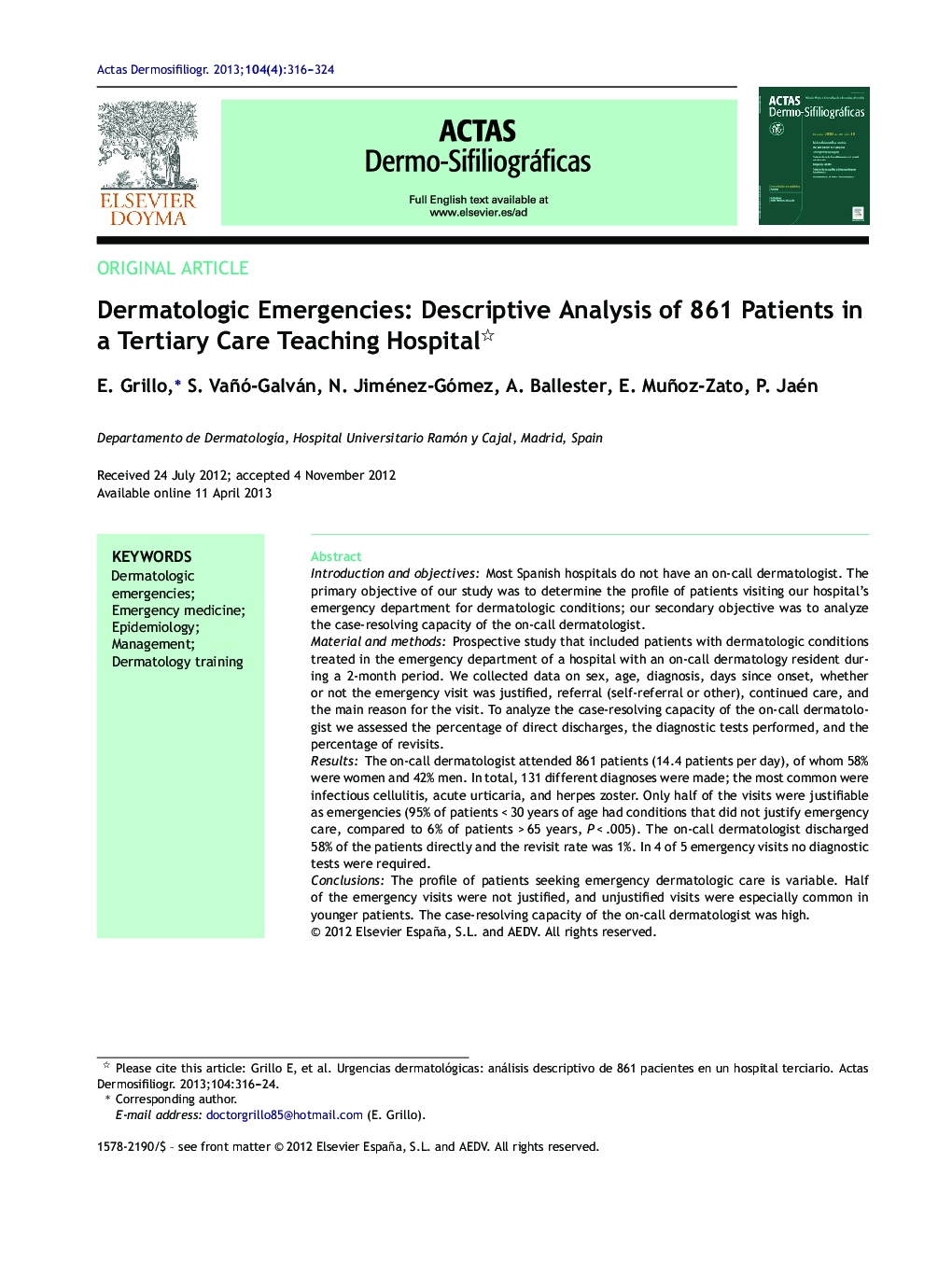| Article ID | Journal | Published Year | Pages | File Type |
|---|---|---|---|---|
| 3183066 | Actas Dermo-Sifiliográficas (English Edition) | 2013 | 9 Pages |
Introduction and objectivesMost Spanish hospitals do not have an on-call dermatologist. The primary objective of our study was to determine the profile of patients visiting our hospital's emergency department for dermatologic conditions; our secondary objective was to analyze the case-resolving capacity of the on-call dermatologist.Material and methodsProspective study that included patients with dermatologic conditions treated in the emergency department of a hospital with an on-call dermatology resident during a 2-month period. We collected data on sex, age, diagnosis, days since onset, whether or not the emergency visit was justified, referral (self-referral or other), continued care, and the main reason for the visit. To analyze the case-resolving capacity of the on-call dermatologist we assessed the percentage of direct discharges, the diagnostic tests performed, and the percentage of revisits.ResultsThe on-call dermatologist attended 861 patients (14.4 patients per day), of whom 58% were women and 42% men. In total, 131 different diagnoses were made; the most common were infectious cellulitis, acute urticaria, and herpes zoster. Only half of the visits were justifiable as emergencies (95% of patients < 30 years of age had conditions that did not justify emergency care, compared to 6% of patients > 65 years, P < .005). The on-call dermatologist discharged 58% of the patients directly and the revisit rate was 1%. In 4 of 5 emergency visits no diagnostic tests were required.ConclusionsThe profile of patients seeking emergency dermatologic care is variable. Half of the emergency visits were not justified, and unjustified visits were especially common in younger patients. The case-resolving capacity of the on-call dermatologist was high.
ResumenIntroducción y objetivosLa mayoría de hospitales españoles no dispone de dermatólogo de guardia. El objetivo del estudio fue conocer el perfil de paciente que acude a Urgencias por un proceso dermatológico y de manera secundaria analizar la capacidad resolutiva del dermatólogo de guardia.Material y métodosEstudio prospectivo que incluyó pacientes con afección dermatológica atendidos en Urgencias de un hospital con residente de Dermatología de guardia durante un periodo de 2 meses. Se recogió sexo, edad, diagnóstico, días de evolución, justificación o no de la consulta urgente, procedencia, destino tras la asistencia y motivo principal de la consulta. Para analizar la capacidad resolutiva del dermatólogo de guardia se valoró el porcentaje de altas directas, las pruebas complementarias realizadas y el porcentaje de revisitas.ResultadosSe atendieron 861 pacientes —58% mujeres y 42% varones—(14,4 pacientes al día). Se realizaron 131 diagnósticos distintos, siendo los más frecuentes celulitis infecciosa, urticaria aguda y herpes zóster. Solo la mitad del total de consultas tenían un motivo urgente justificado (el 95% de los pacientes menores de 30 años acudió sin motivo urgente justificado, frente al 6% de pacientes mayores de 65 años, p < 0.005). El dermatólogo de guardia dio el alta directa al 58% de los pacientes y se registró un porcentaje de revisitas < 1%. En 4 de cada 5 urgencias atendidas no se requirió ninguna prueba complementaria.ConclusionesEl perfil de paciente con enfermedad urgente dermatológica es variable. En la mitad de las consultas no se encontró un motivo justificado de urgencia, especialmente en pacientes jóvenes. El dermatólogo de guardia presentó una alta capacidad resolutiva.
